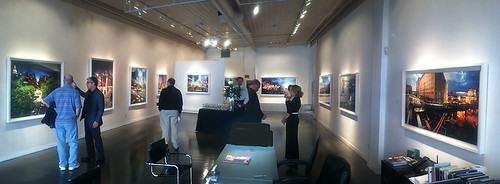THE Magazine Review: Stephen Wilkes: Day to Night
October 17, 2012 | Source: Monroe Gallery of Photography
Installation Photograph by Stephen Wilkes
The Magazine
Critcal Reflections
June, 2012
Iris McLister
Are you a city person? Do you like hailing a taxi or looking upward to see the tippy top of a skyscraper?
Maybe you're more of a country mouse like me, and being among millions of people with places to go and people to see leaves you cold. My only, very brief, visit to New York City, several years ago, left my feathers substantially ruffled. The rush, the anonymity, the impossible task of trying to be nonchalant about riding the subway; the everywhere presence of interesting-looking people I'd never know or even meet.
No, not all of us are city people. Contemporary photographer Stephen Wilkes chose New York City as his subject for his series Day to Night, capturing moments of astonishing urban beauty in luscious, vivid color. His unique digitally manipulated, time-lapse photography allows the course of an entire day to be viewed in one image, thereby exposing the city's constant energy while suggesting its ultimate stability.
We've all seen pictures of the Empire State Building or the Brooklyn Bridge at dusk; these aren't those. The first thing you notice about the photos in Day to Night is the uncanny quality of light they capture; they look lit up from within. Wilkes has been a commercial photographer for many years, working for major publications like Sports Illustrated, Vanity Fair, The New York Times Magazine, and Time. As a fine-art photographer, his work reaches similarly wide audiences and often has political undertones. A series shot on Ellis Island depicts eerie scenes of dilapidated buildings and neglected grounds—it garnered so much attention that it helped prompt Congress to grant the area millions of preservation dollars and designate it as a "living ruin." In a 2008 body of photographs taken in China, Wilkes conveyed in equal measure the sterile coldness of sprawling factories and the humanity of their workers.
For this more neutral, but visually dazzling, body of work, the artist began by choosing an iconic New York City location like Central Park or Washington Square. Perched fifty feet above ground level in a rented boom lift, the artist spent ten to fifteen hours taking hundreds of pictures of the same scene throughout the course of a day, painstakingly ensuring that every shot came from the same, fixed perspective.
Wilkes then blended together dozens or so carefully chosen shots with digital photo software to forge utterly seamless portrayals of a day's shift into night. Painstakingly detailed and full of nuance, a single image can take months to create. Photographs take on time-travel qualities in their ability to relate distinct times of day in just one frame. In Gramercy Park, this city landmark becomes a dense forest, composed so that the vermillion shock of tall trees in the foreground gives way, somewhat ominously, to darkened evening skies. Apartment building windows are so warmly and clearly lit you can almost make out figures, and the bizarre lighting, which Wilkes sometimes manipulates into veritable fluorescence, suggests the contrivance of a movie set or a starkly illuminated dollhouse. In Park Avenue, rows of golden yellow cabs stream down traffic lanes in a scene of ecstatic motion. Thrillingly bright light beams downwards onto the avenue, and an inky-dark, cloudy sky makes a perplexing and delightful backdrop. This is a remarkably beautiful rendering of an urban scene—and it feels consummately new in its depiction. Coney Island is more literal in its representation of a day's transition from morning to night; the evening portion on the left side of the picture gradually turns to brilliant daylight on the right. The neon blur of the Ferris wheel against the night sky gives way to the sunbathers and sailboats creating areas of startling, but somehow organic, contrast. Of these photographs, which Wilkes calls "quintessential city portraits," the artist says: "You realize that the pedestrians are communicating, the cabs [are communicating], all these elements are coming together and creating a complex life form, that's how the city works."
In this eye-catching exhibition, Stephen Wilkes manages to inject scenes of urban New York with a dynamism that conjures universally relatable themes of renewal and change. This work encourages us to celebrate and share in the ineffably triumphant quality of New York City—and it's got this country girl yearning for a visit to the Big Apple.
The exhibition has been extended through June 24, 2012.


